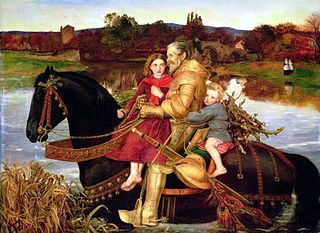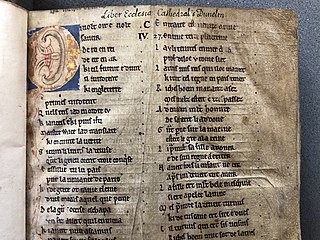Matilda of Flanders was Queen of England and Duchess of Normandy by marriage to William the Conqueror, and regent of Normandy during his absences from the duchy. She was the mother of nine children who survived to adulthood, including two kings, William II and Henry I.

Robert I of Normandy, also known as Robert the Magnificent and by other names, was a Norman noble of the House of Normandy who ruled as duke of Normandy from 1027 until his death in 1035. He was the son of Duke Richard II; the brother of Duke Richard III, against whom he unsuccessfully revolted; and the father of Duke William who became the first Norman king of England after winning the Battle of Hastings in 1066. During his reign, Robert quarrelled with the church—including his uncle Robert, archbishop of Rouen—and meddled in the disorder in Flanders. He finally reconciled with his uncle and the church, restoring some property and undertaking a pilgrimage to Jerusalem, during which he died.

A Breton lai, also known as a narrative lay or simply a lay, is a form of medieval French and English romance literature. Lais are short, rhymed tales of love and chivalry, often involving supernatural and fairy-world Celtic motifs. The word "lay" or "lai" is thought to be derived from the Old High German and/or Old Middle German leich, which means play, melody, or song, or as suggested by Jack Zipes in The Oxford Companion to Fairy Tales, the Irish word laid (song).
Anglo-Norman literature is literature composed in the Anglo-Norman language and developed during the period of 1066–1204, as the Duchy of Normandy and the Kingdom of England were united in the Anglo-Norman realm.

Bevis of Hampton (Old French: Beuve(s) or Bueve or Beavisde Hanton(n)e; Anglo-Norman: Boeve de Haumtone; Italian: Buovo d'Antona) or Sir Bevois was a legendary English hero and the subject of Anglo-Norman, Dutch, French, English, Venetian, and other medieval metrical chivalric romances that bear his name. The tale also exists in medieval prose, with translations to Romanian, Russian, Dutch, Irish, Welsh, Old Norse and Yiddish.

As a literary genre, the chivalric romance is a type of prose and verse narrative that was popular in the noble courts of high medieval and early modern Europe. They were fantastic stories about marvel-filled adventures, often of a chivalric knight-errant portrayed as having heroic qualities, who goes on a quest. It developed further from the epics as time went on; in particular, "the emphasis on love and courtly manners distinguishes it from the chanson de geste and other kinds of epic, in which masculine military heroism predominates."

The Seven Wise Masters is a cycle of stories of Sanskrit, Persian or Hebrew origins.

The story of the Knight of the Swan, or Swan Knight, is a medieval tale about a mysterious rescuer who comes in a swan-drawn boat to defend a damsel, his only condition being that he must never be asked his name.

Nicholas Trivet was an English Anglo-Norman chronicler.

Sir Isumbras is a medieval metrical romance written in Middle English and found in no fewer than nine manuscripts dating to the fifteenth century. This popular romance must have been circulating in England before 1320, because William of Nassyngton, in his work Speculum Vitae, which dates from this time, mentions feats of arms and other 'vanities', such as those found in stories of Sir Guy of Warwick, Bevis of Hampton, Octavian and Sir Isumbras. Unlike the other three stories, the Middle English Sir Isumbras is not a translation of an Old French original.

The Brut or Roman de Brut by the poet Wace is a loose and expanded translation in almost 15,000 lines of Norman-French verse of Geoffrey of Monmouth's Latin History of the Kings of Britain. It was formerly known as the Brut d'Engleterre or Roman des Rois d'Angleterre, though Wace's own name for it was the Geste des Bretons, or Deeds of the Britons. Its genre is equivocal, being more than a chronicle but not quite a fully-fledged romance.
"Le Fresne" is one of the Lais of Marie de France. It was likely written in the late 12th century. Marie claims it to be a Breton lai, an example of Anglo-Norman literature.

Grateful dead is both a motif and a group of related folktales present in many cultures throughout the world.

The Vitae duorum Offarum "The lives of the two Offas" is a literary history written in the mid-thirteenth century, apparently by the St Albans monk Matthew Paris; however, the most recent editor and translator of the work rejects this attribution and argues for an earlier date, in the late twelfth century. The earliest editor, William Wats, argues that the texts are older than Matthew's day but were revised by him; he bases this view on stylistic elements, such as the inclusion in the first Vita of a quotation from Lucan which also appears repeatedly in Matthew's Chronica maiora.

The Normans were a population arising in the medieval Duchy of Normandy from the intermingling between Norse Viking settlers and locals of West Francia. The Norse settlements in West Francia followed a series of raids on the French northern coast mainly from what is now Denmark, although some also sailed from Norway and Sweden. These settlements were finally legitimized when Rollo, a Scandinavian Viking leader, agreed to swear fealty to King Charles III of West Francia following the siege of Chartres in 911. The intermixing in Normandy produced an ethnic and cultural "Norman" identity in the first half of the 10th century, an identity which continued to evolve over the centuries. The Normans adopted the culture and language of the French, while they continued the martial tradition of their Viking ancestors as mercenaries and adventurers. In the 11th century, Normans from the duchy conquered England and southern Italy.

Ipomadon is a Middle English translation of Hugh of Rhuddlan's Anglo-Norman romance Ipomedon composed in tail-rhyme verse, possibly in the last decade of the fourteenth century. It is one of three Middle English renditions of Hugh's work: the other two are a shorter verse Lyfe of Ipomydon and the prose Ipomedon, both of the fifteenth century. Each version is derived independently from the Anglo-Norman Ipomedon, which Hugh wrote 'not long after 1180', possibly in Herefordshire. It is included in a list of the popular English romances by Richard Hyrde in the 1520s.

Sir Gowther is a relatively short Middle English tail-rhyme romance in twelve-line stanzas, found in two manuscripts, each dating to the mid- or late-fifteenth century. The poem tells a story that has been variously defined as a secular hagiography, a Breton lai and a romance, and perhaps "complies to a variety of possibilities". An adaptation of the story of Robert the Devil, the story follows the fortunes of Sir Gowther from birth to death, from his childhood as the son of a fiend, his wicked early life, through contrition and a penance imposed by the Pope involving him in a lowly and humiliating position in society, and to his eventual rise, via divine miracles, as a martial hero and ultimately to virtual canonization. But despite this saintly end, "like many other lays and romances, Sir Gowther derives much of its inspiration from a rich and vastly underappreciated folk tradition."
Sir Cleges is a medieval English verse chivalric romance written in tail-rhyme stanzas in the late 14th or early 15th century. It is clearly a minstrel tale, praising giving gifts to minstrels, and punishing the servants who might make it impossible for a minstrel in a noble household. Corrupt officials are central to it.

Athelston is an anonymous Middle English verse romance in 812 lines, dating from the mid or late 14th century. Modern scholars often classify it as a "Matter of England" romance, because it deals entirely with pre-Conquest English settings and characters. It is mainly written in twelve-line stanzas rhyming AABCCBDDBEEB, though the poet occasionally varies his meter with stanzas of eight, six, or four lines. The poem survives in only one manuscript, the early 15th-century Gonville and Caius MS 175, which also includes the romances Richard Coer de Lyon, Sir Isumbras and Beves of Hamtoun. It has no title there. Athelston was first printed in 1829, when C. H. Hartshorne included it in his Ancient Metrical Tales.
The Folie Tristan d’Oxford, also known as the Oxford Folie Tristan, The Madness of Tristan, or Tristan’s Madness, is a poem in 998 octosyllabic lines written in Anglo-Norman, the form of the Norman language spoken in England. It retells an episode from the Tristan legend in which Tristan disguises himself as a madman to win his way back to Ysolt. The poem can be dated to the period 1175–1200, but the name of the author is unknown. It is not to be confused with the Folie Tristan de Berne, a different medieval poem on the same subject, each work taking its name from the city in which the manuscript is now kept.
















